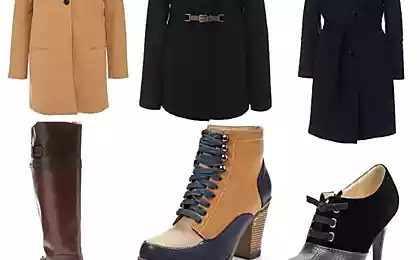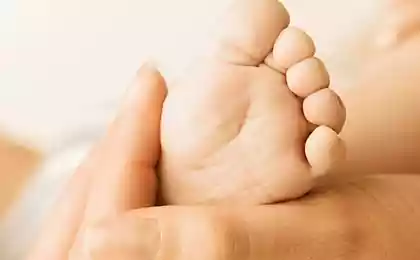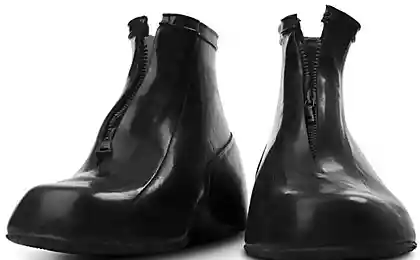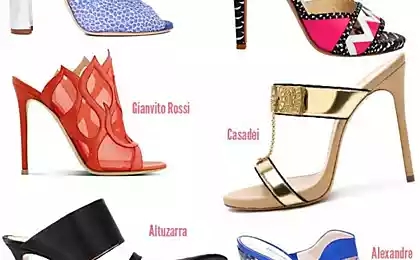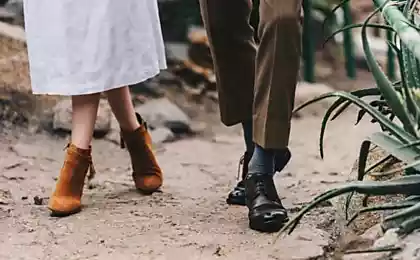1849
Different types of shoes
It has a long history of shoes she appeared about 26-30 thousand years ago. Some kinds of shoes, having undergone some changes, used to this day, some can also be found only in museums and private collections. We offer you a selection of the 10 most bizarre kinds of shoes, from the ancient to the modern. The tradition of binding women's feet with special bandages to the foot as small as possible, there are several thousands of years in China. Traditionally, women were made shoes to prove their ability to sew and small size feet. After the wedding, the groom gave his bride every pair of shoes during a special ceremony. Shanghai fashionista XIX- end of the beginning of the XX century (while Shanghai was the fashion capital of China) were "Lotus" with some heels and a resident of the southern provinces chose "Lotus" of black silk or cotton flat shoes. The last factory for the production of slippers in the province Chzhedzyan. The factory produced shoes for the elderly Chinese women who still follow the old tradition. This factory is still there, but now is not engaged in mass production, and production of footwear under individual orders.

Ballet shoes has become part of modern fashion. First, it was the subject of such footwear fetish individuals, but now has become very popular among ordinary citizens, especially in Japan. These shoes are similar to regular ballet slippers, but they are distinguished by a very high heel. This structure gives the feel of shoes for women, if they are in pointe. These shoes became popular in the 1980s. and now you can buy them in specialized shops all around the world. Of course, such shoes are not designed for continuous wear.

These strange clogs appeared in the Ariege region of France in the 8th century, when the locals took over the camp of the Moors, and, according to legend, their hearts stomped his wooden shoes. These clogs were made from the trunk of a walnut. Men made these shoes for their future brides. It was said that the higher the toe of the shoe, the more a man loves a woman.
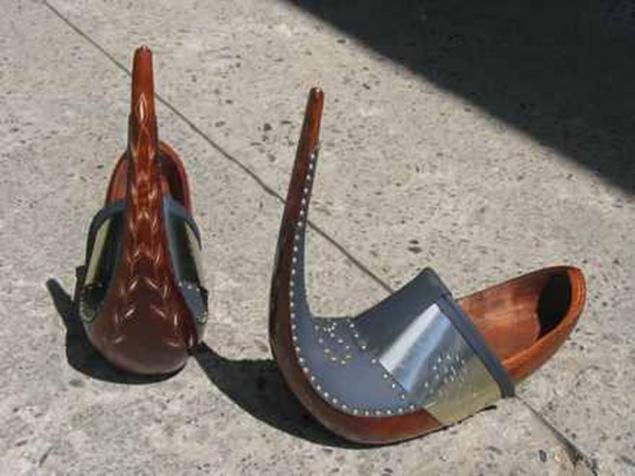
Padukas - Indian ceremonial shoes with a peg between the toes. It is the oldest shoes in India. Padukas produced by human foot, then in a wooden peg inserted into the foundation, which relied on walking (it is next to the thumb). The peg can be wood, metal, silver or made of ivory. There are models with a pointed peg created especially for masochists, .Such padukas enjoyed popularity among the people of the sacred cult.

Some modern designer shoes can also take pride of place in this list. Shoes with a heel recess instead appeared in a collection Antonio Berardi in 2007, a famous by Victoria Beckham in 2008. In spite of the extremely uncomfortable and unnatural-looking design, this shoe is very comfortable - at least so says its creator. According to Antonio Berardi, this model is perfectly balanced, and when the client first comes to fitting, they look for shoes with caution, but when a couple is ready, it is recognized that it is no different from ordinary shoes. However, doctors do not agree with him: the regular wearing such shoes can cause permanent damage to the foot, knee and spine.

Few museums can boast these buskins. For the first time these shoes were in the Renaissance in Italy. As the Chinese "Lotus", these shoes were extremely uncomfortable. They dress to stand out from the crowd and attract attention. The heel of the shoe was at the height of 18 cm, in those days, shoes were the peak of fashion and were very expensive. These shoes were made of wood, covered with silk or velvet. They were decorated with silver details. But most interesting is that these mega shoes barely be seen from the long dresses of medieval women.

In the 20th century, many people wore sandals. They were also worn over the basic shoe (like galoshes) to protect the expensive leather from rain, dirt and snow. They were made of birch and linden bark. In Norway, Sweden and Russia had their own variations of the shoe. These shoes, as in the photo, it was possible to carry a maximum of one week

Wooden shoes "Kabkabayah" were very common among women from rich families in the Middle East, who wore them to protect from dirt and mud. These shoes were decorated with silk, leather or velvet. The name "Kabkabayah" they received for the sound that is published, when women wore them on the marble floor. For special occasions Kabkabayah decorated with silver details.

Socks and shoes with heels are widespread among men in 1700., About the same time when the bridges have become popular. King Louis XIV was very fond of high heels. Of course, all the nobility hastened to adopt a new fashion trend set by the king.

Geisha in Japan put okobo long before modern shoe platform. These clogs were not so much a tribute to fashion, they wore practical soobrazheniy.Tot who wore expensive kimono and was forced to go out in the slush and mud, did not want to spoil its chic outfit. Height okobo usually reaches 14 cm. The color v-shaped strap between the toes depended on the status of a Geisha. Young geisha okobo dressed with a red stripe, those who postarshe- yellow.

Source: www.clamorly.com

Ballet shoes has become part of modern fashion. First, it was the subject of such footwear fetish individuals, but now has become very popular among ordinary citizens, especially in Japan. These shoes are similar to regular ballet slippers, but they are distinguished by a very high heel. This structure gives the feel of shoes for women, if they are in pointe. These shoes became popular in the 1980s. and now you can buy them in specialized shops all around the world. Of course, such shoes are not designed for continuous wear.

These strange clogs appeared in the Ariege region of France in the 8th century, when the locals took over the camp of the Moors, and, according to legend, their hearts stomped his wooden shoes. These clogs were made from the trunk of a walnut. Men made these shoes for their future brides. It was said that the higher the toe of the shoe, the more a man loves a woman.

Padukas - Indian ceremonial shoes with a peg between the toes. It is the oldest shoes in India. Padukas produced by human foot, then in a wooden peg inserted into the foundation, which relied on walking (it is next to the thumb). The peg can be wood, metal, silver or made of ivory. There are models with a pointed peg created especially for masochists, .Such padukas enjoyed popularity among the people of the sacred cult.

Some modern designer shoes can also take pride of place in this list. Shoes with a heel recess instead appeared in a collection Antonio Berardi in 2007, a famous by Victoria Beckham in 2008. In spite of the extremely uncomfortable and unnatural-looking design, this shoe is very comfortable - at least so says its creator. According to Antonio Berardi, this model is perfectly balanced, and when the client first comes to fitting, they look for shoes with caution, but when a couple is ready, it is recognized that it is no different from ordinary shoes. However, doctors do not agree with him: the regular wearing such shoes can cause permanent damage to the foot, knee and spine.

Few museums can boast these buskins. For the first time these shoes were in the Renaissance in Italy. As the Chinese "Lotus", these shoes were extremely uncomfortable. They dress to stand out from the crowd and attract attention. The heel of the shoe was at the height of 18 cm, in those days, shoes were the peak of fashion and were very expensive. These shoes were made of wood, covered with silk or velvet. They were decorated with silver details. But most interesting is that these mega shoes barely be seen from the long dresses of medieval women.

In the 20th century, many people wore sandals. They were also worn over the basic shoe (like galoshes) to protect the expensive leather from rain, dirt and snow. They were made of birch and linden bark. In Norway, Sweden and Russia had their own variations of the shoe. These shoes, as in the photo, it was possible to carry a maximum of one week

Wooden shoes "Kabkabayah" were very common among women from rich families in the Middle East, who wore them to protect from dirt and mud. These shoes were decorated with silk, leather or velvet. The name "Kabkabayah" they received for the sound that is published, when women wore them on the marble floor. For special occasions Kabkabayah decorated with silver details.

Socks and shoes with heels are widespread among men in 1700., About the same time when the bridges have become popular. King Louis XIV was very fond of high heels. Of course, all the nobility hastened to adopt a new fashion trend set by the king.

Geisha in Japan put okobo long before modern shoe platform. These clogs were not so much a tribute to fashion, they wore practical soobrazheniy.Tot who wore expensive kimono and was forced to go out in the slush and mud, did not want to spoil its chic outfit. Height okobo usually reaches 14 cm. The color v-shaped strap between the toes depended on the status of a Geisha. Young geisha okobo dressed with a red stripe, those who postarshe- yellow.

Source: www.clamorly.com


